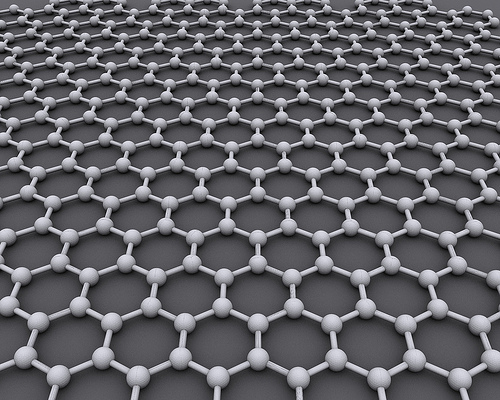A graphene research initiative has been selected by the European Commission as one of two winners of its Future and Emerging Technologies (FET) multi-billion euro research excellence award competition. Each project will receive €1 billion to fund 10 years of research “at the crossroads of science and technology” — the biggest research grant ever awarded by the Commission. The second winner of the FET award is a project that aims to develop a model of the human brain.
The Graphene project will “investigate and exploit the unique properties of a revolutionary carbon-based material” — exploring the physical and chemical properties of a material that is just one atom thick; conducts electricity much better than copper; is 100 to 300 times stronger than steel; and has “unique optical properties”.
Researchers have already been looking at how graphene could improve battery capacity and exploring its water-repelling properties. But the EC is betting on graphene becoming “the wonder material of the 21st Century” — replacing silicon in ICT products and becoming as important as plastics were to the 20th Century:
Graphene: this material looks to become as important as steel or plastics in the long-term. Research on graphene is an example of an emerging translational nanotechnology where discoveries in academic laboratories are rapidly transferred to applications and commercial products. Graphene and related materials have the potential to make a profound impact in ICT in the short and long term: integrating graphene components with silicon-based electronics, and gradually replacing silicon or enabling completely new applications. Beyond ICT, graphene research will significantly impact energy and transport, and also health.
The Graphene FET flagship project will be led by Professor Jari Kinaret, from Sweden’s Chalmers University, and will involve more than 100 research groups, with 136 principal investigators, including four Nobel laureates.
The consortium of research partners also includes industry members from a variety of sectors. One industry partner in the graphene consortium, mobile maker Nokia, said it is “flying the flag for the electronics corner, as well as the mobile one, with realistic dreams of improving the industry”. Writing on the Nokia Conversations blog, Henry Tirri, EVP, CTO of Nokia, said the company started researching graphene in 2006, adding: “Since then, we have come to identify multiple areas where this material can be applied in modern computing environments. We’ve done some very promising work so far, but I believe the greatest innovations have yet to be discovered.”
Nokia’s Tapani Ryhänen, Head of the Sensor and Material Technologies Laboratory at Nokia, added that graphene’s impact will not just be in the future, through the development of new materials, but that graphene will be able to improve existing materials and products in the near term. “We have kept our eyes open, and believe that this will bring immediate impact to our products over the coming years in some way or another,” he wrote.
The second FET competition winner, called the Human Brain Project, will create the word’s largest experimental facility for developing the most detailed model of the brain. The model will be used to study how the human brain works — with the ultimate aim of developing personalised treatment of neurological and related diseases. The project involves scientists from 87 institutions and is led by Professor Henry Markram of the École Polytechnique Fédérale de Lausanne.
The EC said sustained funding for the full duration of the projects will come from the EU’s research framework programmes — principally the Horizon 2020 programme, which kicks off next year and is currently having its budget negotiated in the European Parliament and Council. The ambitious scope and scale of FET — both in the level of funding but also the length of the research period — was designed to increase the level of science in the research projects, to aim for “greater benefits to Europe over the long-term, including new technologies and faster innovation”, according to the EC.
Commenting on the two winners, EC Vice President Neelie Kroes said in a statement: “Europe’s position as a knowledge superpower depends on thinking the unthinkable and exploiting the best ideas. This multi-billion competition rewards home-grown scientific breakthroughs and shows that when we are ambitious we can develop the best research in Europe.”
Speaking at the press conference announcing the winners, Kroes added that she wanted the project to result in “graphene valley” being situated in Europe — “the home to the successor to Silicon Valley”. “The story of graphene shows there is still wonder in science,” she added.
Last week, Cambridge University announced it would be opening a new £25 million Graphene Research Centre, backed by government funding grants and industry support, including from Nokia, Plastic Logic, Philips, Dyson and BaE systems.
[Image by CORE-Materials via Flickr]
